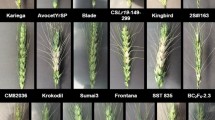Abstract
Fusarium head blight (FHB), caused by Fusarium graminearum Schwabe [telomorph = Gibberella zeae (Schw.) Petch], is a persistent threat to wheat production. Development of resistant varieties and identification of germplasm carrying new sources of resistance is necessary to preserve grain quality and yield. Resistance to FHB has been identified both within the gene pools of cultivated wheat and wild wheat relatives. In this study, a collection of the D genome species, Aegilops tauschii Coss. was evaluated for resistance to FHB. A total of 109 accessions of Ae. tauschii Coss. subsp. tauschii and Ae. tauschii Coss. subsp. strangulata (Eig) Tzvelev were infected with F. graminearum by single floret inoculation. Disease severity was rated as the percentage of infected spikelets at 21 days post-inoculation. A strong relationship was identified between geographical origin of Ae. tauschii accessions and FHB resistance. Generally, accessions from areas receiving high levels of annual rainfall were resistant whereas accessions from areas of low rainfall, more susceptible to FHB. High levels of FHB resistance were identified in accessions collected from regions bordering the Caspian Sea. The majority of accessions from arid regions were susceptible to FHB. The resistant germplasm identified in this study will support long-term FHB resistance breeding efforts.


Similar content being viewed by others
References
Benson J, Brown-Guedira G, Murphy JP, Sneller C (2012) Population structure, linkage disequilibrium, and genetic diversity in soft winter wheat enriched for Fusarium head blight resistance. Plant Genome 5:71–80
Buerstmayr H, Ban T, Anderson JA (2009) QTL mapping and marker-assisted selection for Fusarium head blight resistance in wheat: a review. Plant Breed 128:1–26
Buerstmayr M, Alimari A, Steiner B, Buerstmayr H (2013) Genetic mapping of QTL for resistance to Fusarium head blight spread (type 2 resistance) in a Triticum dicoccoides× Triticum durum backcross-derived population. Theor Appl Genet 126:2825–2834
Cainong JC, Bockus W, Feng Y, Chen P, Qi L, Sehgal SK, Danilova TV, Koo DH, Friebe B, Gill BS (2015) Chromosome engineering, mapping, and transferring of resistance to Fusarium head blight disease from Elymus tsukushiensis into wheat. Theor Appl Genet 128:1019–1027
Chen P, Liu W, Yuan J, Wang X, Zhou B, Wang S, Zhang S, Feng Y, Yang B, Liu G, Liu D, Qi L, Zhang P, Friebe B, Gill BS (2005) Development and characterization of wheat-Leymus racemosus translocation lines with resistance to Fusarium Head Blight. Theor Appl Genet 111:941–948
Chen X, Faris JD, Hu J, Stack RW, Adhikari T, Elias EM, Kianian SF, Cai X (2007) Saturation and comparative mapping of a major Fusarium head blight resistance QTL in tetraploid wheat. Mol Breed 19:113–124
Dvorak J, Luo MC, Yang ZL, Zhang HB (1998) The structure of the Aegilops tauschii genepool and the evolution of hexaploid wheat. Theor Appl Genet 97:657–670
Garvin DF, Stack RW, Hansen JM (2009) Quantitative trait locus mapping of increased Fusarium head blight susceptibility associated with a wild emmer wheat chromosome. Phytopathol 99:447–452
Gill BS, Raupp WJ (1987) Direct genetic transfers from Aegilops squarrosa L. to hexaploid wheat. Crop Sci 27:445–450
Guo J, Zhang X, Hou Y, Cai J, Shen X, Zhou T, Xu H, Ohm HW, Wang H, Li A, Han F, Wang H, Kong L (2015) High-density mapping of the major FHB resistance gene Fhb7 derived from Thinopyrum ponticum and its pyramiding with Fhb1 by marker-assisted selection. Theor Appl Genet 128:2301–2316
Hallen-Adams HE, Cavinder BL, Trail F (2011) Fusarium graminearum from expression analysis to functional assays. In: Jin-Rong Xu, Bluhm Burton H (eds) Fungal genomics: methods and protocols. Springer, Berlin, pp 79–101
Johnson HW, Robinson HF, Comstock RE (1955) Estimation of genetic and environmental variability in soybeans. Agron J 47:314–318
McArthur RI, Zhu X, Oliver RE, Klindworth DL, Xu SS, Stack RW, Wang RR, Cai X (2012) Homoeology of Thinopyrum junceum and Elymus rectisetus chromosomes to wheat and disease resistance conferred by the Thinopyrum and Elymus chromosomes in wheat. Chromosome Res 20:699–715
Oliver RE, Cai X, Xu SS, Chen X, Stack RW (2005) Wheat-alien species derivatives: a novel source of resistance to Fusarium head blight in wheat. Crop Sci 45:1353–1360
Oliver RE, Xu SS, Stack RW, Friesen TL, Jin Y, Cai X (2006) Molecular cytogenetic characterization of four partial wheat-Thinopyrum ponticum amphiploids and their reactions to Fusarium head blight, tan spot, and Stagonospora nodorum blotch. Theor Appl Genet 112:1473–1479
Qi LL, Pumphrey MO, Friebe B, Chen P, Gill BS (2008) Molecular cytogenetic characterization of alien introgressions with gene Fhb3 for resistance to Fusarium head blight disease of wheat. Theor Appl Genet 117:1155–1166
R Core Team (2015) R: a language and environment for statistical computing. R Foundation for Statistical Computing, Vienna, Austria
Wang J, Luo MC, Chen Z, You FM, Wei Y, Zheng Y, Dvorak J (2013) Aegilops tauschii single nucleotide polymorphisms shed light on the origins of wheat D-genome genetic diversity and pinpoint the geographic origin of hexaploid wheat. New Phytol 198:925–937
Acknowledgements
We thank USDA-ARS, U.S. Wheat and Barley Scab Initiative and The Michigan Wheat Program for financial support to conduct this work.
Author contributions
EIB and, ELO designed research and objectives; EIB and ELO performed research; LKB, EIB and ELO analyzed data; ELO and EIB wrote the manuscript.
Author information
Authors and Affiliations
Corresponding author
Ethics declarations
Conflict of interest
The authors of this study declare that there is no conflict of interest for this study.
Ethical standard
This research complies with the current laws of the United States of America.
Electronic supplementary material
Below is the link to the electronic supplementary material.
Rights and permissions
About this article
Cite this article
Brisco, E.I., Brown, L.K. & Olson, E.L. Fusarium head blight resistance in Aegilops tauschii . Genet Resour Crop Evol 64, 2049–2058 (2017). https://doi.org/10.1007/s10722-017-0495-3
Received:
Accepted:
Published:
Issue Date:
DOI: https://doi.org/10.1007/s10722-017-0495-3




